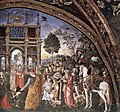User:Stelle-Pluto/The Hall of the Saints (Pinturicchio)
| This is the sandbox page where you will draft your initial Wikipedia contribution.
If you're starting a new article, you can develop it here until it's ready to go live. If you're working on improvements to an existing article, copy only one section at a time of the article to this sandbox to work on, and be sure to use an edit summary linking to the article you copied from. Do not copy over the entire article. You can find additional instructions here. Remember to save your work regularly using the "Publish page" button. (It just means 'save'; it will still be in the sandbox.) You can add bold formatting to your additions to differentiate them from existing content. |
/The Hall of the Saints(Pinturicchio)
Article Draft
[edit]Lead
[edit]Article body
[edit]| Hall of the Saints | |
|---|---|
| Sala dei Santi | |
 | |
| Artist | Pinturicchio |
| Year | 1491-1494 |
| Medium | fresco |
| Location | Vatican Palace |
The Hall of the Saints or the Sala dei Santi is a room in the Borgia Apartment of the Vatican Palace, frescoed by the Italian Renaissance artist, Pinturicchio. It dates to 1491–1494 and was commissioned by Pope Alexander VI. The frescoes depict scenes from the lives of the saints. The ceiling fresco, which depicts myths related to the ancient Egyptian gods Osiris and Isis, has been the subject of much scholarly attention.[1] The iconographic program reflects the humanistic interests of Alexander and was likely designed by his secretary, Giovanni Annio of Viterbo.[2]
<<History
[edit]- Pope Alexander VI
- “…the Borgia family’s heraldic symbol, the ox. Alexander VI …had a special affection for this creature, which appears in impressive numbers and in a variety of scales, colors, and media throughout the decoration of the Borgia rooms (apartment).” (Curran, p.107–108)
- Pinturicchio
- Borgia Apartment (notes)
- “…the Sala de Santi is [placed] at the center of the Borgia suite, on the floor directly below the rooms decorated by Raphael for Julius II and Leo X…known as the Vatican Stanze.” (Curran, p.108)
- Vatican Place
<<The Frescoes
[edit]- “Some of these frescos also contain allusions to Egypt and Egyptian antiquity…” (Curran, p.107)
Ceiling Fresco
[edit]- Osiris
- Isis
- Most of the images you have to look up at the ceiling to notice the ancient Egyptian gods Osiris, Isis, and bull Apis on plates 5 & 6.
- “Moving to the ceiling, we note that Pinturicchio has illustrated the story of Osiris and Apis in eight scenes that correspond to the triangular spandrels of the oblong cross vaults of the ceiling, which dates to the time of Nicholas V (plates 4 and s).” (Curran, p.109)
<<Subject
[edit]- “…upper walls of the room, which served as a receiving and possible throne room for the second Borgia pope, [Pope] Alexander VI (Rodrigo Borgia , r. 1493–1503), are decorated with scenes from the lives of Alexanders selected and patron saints.” (Curran, p.107)
Identify of figures
[edit]- “…it has been suggested that one of the two prominent Turkish figures in the Disputation could be a portrait of the exiled Ottoman prince Cem (or Djem), who was resident in the Vatican palace as a hostage and potential figurehead of a crusade at the time that the frescoes were painted.” (Curran, p.109)
- “… typical of earlier interpretations that attempted to identify other protagonists in the fresco as portraits of Borgia family members, including Lucrezia (as Catherine) and Cesare. But recent study suggests that both of these Turkish figures are, in fact, generic types who were a standard feature in the art of this period.” (Curran, p.109)
<<Iconography
[edit]- The iconographic program
- (Krén, Emil; Marx, Daniel. "Frescoes in the Borgia Apartments of the Palazzi Pontifici in Vatican". Web Gallery of Art. Retrieved 14 August 2013.)
- “…the imagery in the room provides a visual proclamation of the virtues and aspirations of the Borgia and of Alexander in particular as the divinely sanctioned ruler of the church.” (Curran, p.108)
- “…the Osiris-Apis story provides a myththo-historical justification for the Borgia family’s claim to rule in Italy through their descent from ‘Egyptian’ ancestors.” (Curran, p.108)
- “In the frescoes of the Sala dei Santi, it may be said that the honors of Isis and Osiris had been restored to Rome after a millennium or more of neglect. But while Isis and her consort had been offered sacrifices and other cultic tribute in the temples of the ancients, they return this time in a strictly subordinate position, as forerunners and ‘hieroglyphic emblems’ of the virtues and authority of the Borgia pope. (basic themes of the cycle were largely inspired by the "studies" of Giovanni Nanni, better known as Annius of Viterbo (circa 1432/37-1502).68)” (Curran, p.121)
Gallery
[edit]Notes
[edit]- ^ Curran, Brian (2007). The Egyptian Renaissance : the afterlife of ancient Egypt in early modern Italy. University of Chicago Press. ISBN 978-0-226-12893-1. OCLC 487611853.
- ^ Partridge, Loren (1996). The Art of Renaissance Rome, 1400-1600. New York: Henry N. Abrams. pp. 144–148.
References
[edit]- Curran, Brian. 2007. The Egyptian Renaissance: the afterlife of ancient Egypt in early modern Italy. Chicago: University of Chicago Press.
- Riess, J. B. (1984). "Raphael's Stanze and Pinturiccio's Borgia Apartment." Source (New York, N.Y.), 3(4), 57–67.









